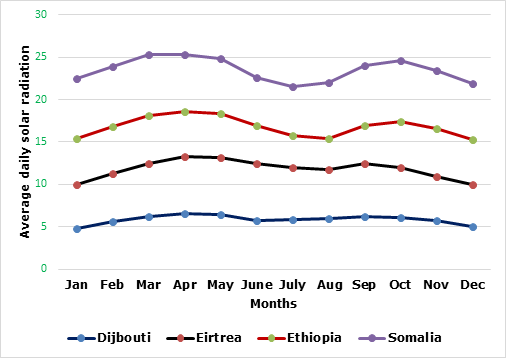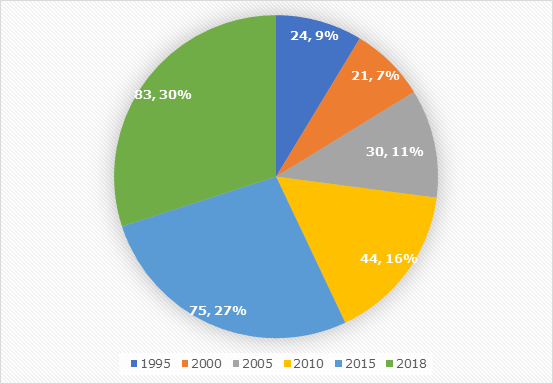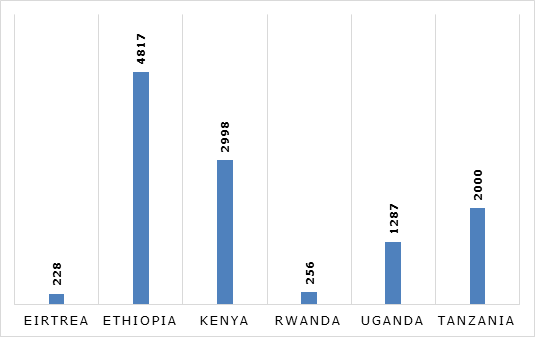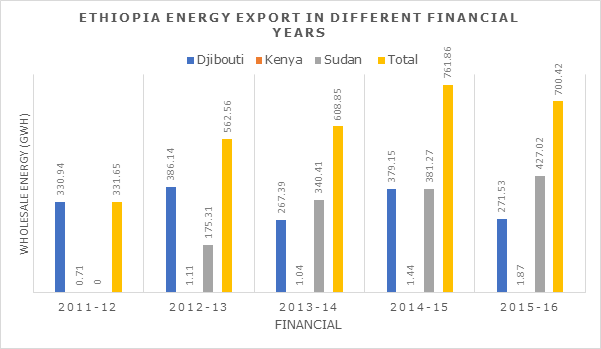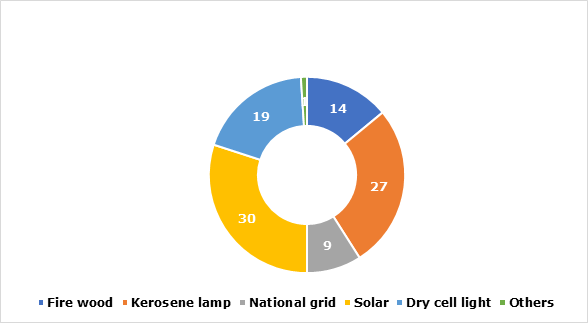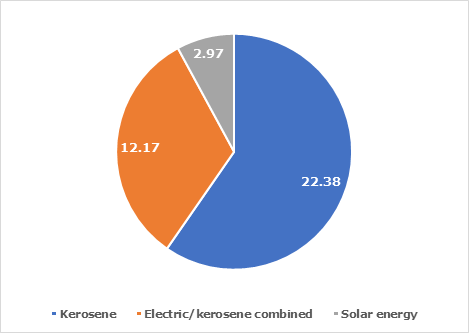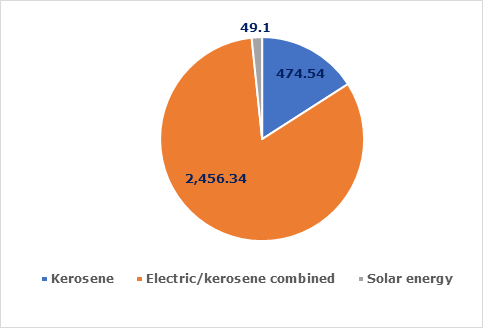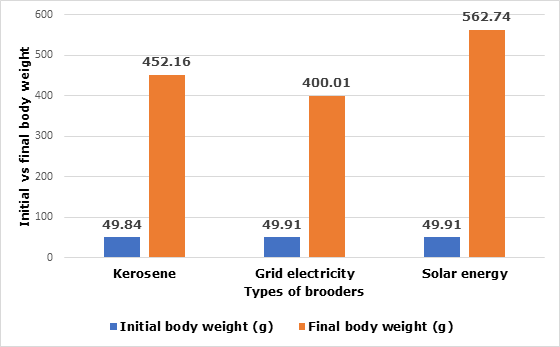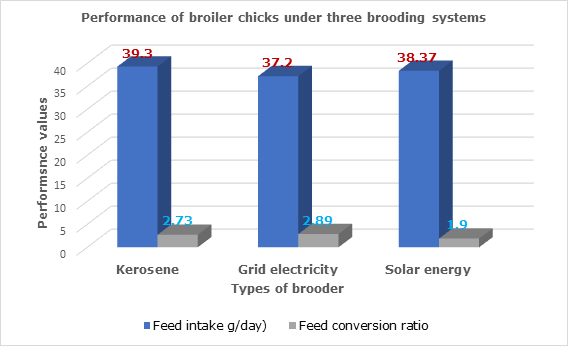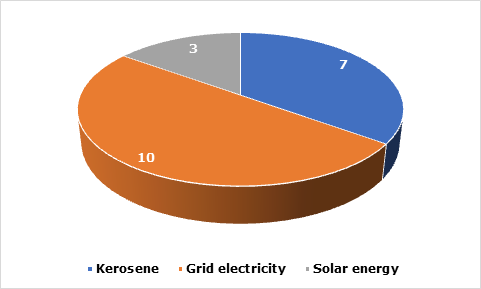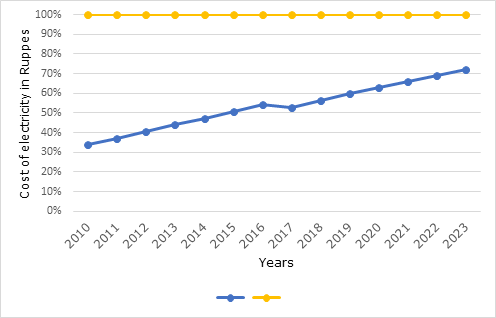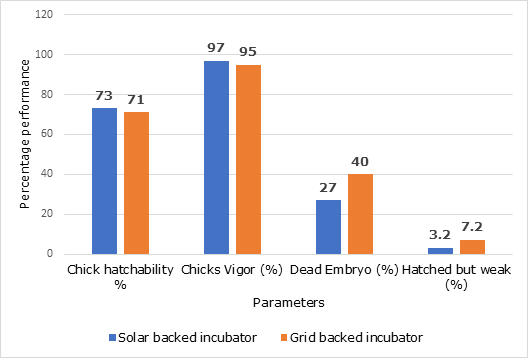Previous Issues Volume 8, Issue 1 - 2024
Energy Ecosystems of Ethiopia: With Special Focus on Solar Power Applications to Poultry Sector: A Review
Tekeba Eshetie*, Dereje Bekele
SNV (Netherlands Development Organization), Addis Ababa, Ethiopia
*Corresponding Author: Tekeba Eshetie, SNV (Netherlands Development Organization), Addis Ababa, Ethiopia; Email: [email protected]/[email protected]
Received Date: December 12, 2023
Publication Date: January 5, 2024
Citation: Eshetie T, et al. (2024). Energy Ecosystems of Ethiopia: With Special Focus on Solar Power Applications to Poultry Sector: A Review. Mathews J Vet Sci. 8(1):35.
Copyright: Eshetie T, et al. © (2024)
ABSTRACT
Ethiopia is one of the countries in Africa in which energy resources are underexploited; as evident from the past, significant energy demands are still met from traditional resources. Currently, the final energy consumption of the country is around 40,000 GWh, of which about 92% is consumed by domestic appliances, 4% by the transport sector, and 3% by industry. On top of these, the energy supply is covered by bioenergy which accounts for about 90% of final energy consumption which in turn has a long-term negative impact on the environment, livelihood, and overall sustainable development of the country. Nowadays, Ethiopia's total installed capacity of electric generation is about 4.5 GW, mainly generated by hydro (90%) and followed by wind energy (7.6%). Ethiopia is endowed with various and diversified renewable energy resources, namely hydro, wind, solar, and geothermal. The estimated exploitable potential for hydropower is 45 GW, wind is 10 GW, geothermal is 5 GW, and solar irradiation ranges from 4.5 kWh/m2/day to 7.5 kWh/m2/day. Despite the abundance and available potential, access to clean energy in the country is one of the lowest in the world. The country's estimated per capita electricity consumption was 70 kWh by 2014 and increased to about 100 kWh by 2017. However, this level is significantly lower than the average per capita energy consumption across all African and Sub-Saharan African countries (500 kWh and 525 kWh), respectively. Obstacles to energy access and low electrification rates have exacerbated socioeconomic inequalities (including gender and rural-urban dividends), which contributed to a lack of energy security, hindered industrial and agriculture development, and increased unemployment. Therefore, to solve this problem, the government of Ethiopia gave strategic priorities in the energy sector, i.e., universal electrification access, energy efficiency improvement, developing decentralized off-grid power generation, and exporting electricity to neighbouring countries. The energy deficiency in the country affects many sectors including the agricultural sector. In the agriculture sector, modern poultry farming is an energy-intensive operation that demands a continuous supply of energy for brooding, lighting, ventilation, incubation, and cooling operations. Most national exploratory reports in modern poultry farming in Ethiopia indicated that, on average, 60-75% of the mortality of chicks is related to poor energy access and limited sustainability during brooding. As a result, those SMEs (Small and Medium Enterprises) are forced to use locally available heat sources like 75 percent charcoal during the brooding period. However, using charcoal as a heat source also has limitations like fire risk and emission of toxic gases like Carbon monoxide, and the cost of charcoal has also significantly increased by 300% in the last two years. Therefore, looking for alternative energy sources that reduce farm operating costs, increase the incomes of farmers and the country, and are environmentally friendly which is timely and crucial. Therefore, the objective of this review article is to explore the energy ecosystems especially renewable (solar) energy potentials of Ethiopia and explore international experiences of using solar power for modern poultry farming, and avail evidence-based information for the poultry value chain actors in Ethiopia. In line with this, the global experience in using solar power in poultry sheds as heat, light, cooling, ventilation, and incubation sources indicated promising results. The use of solar power for chick brooding showed reduced chick mortality, increased feed efficiency, and increased economic return and brought overall positive environmental, and socio-economic impacts. Therefore, solar power can be used in the Ethiopian poultry sector either as a hybrid power with the existing system or as the sole energy source. However, its application should be evaluated at different geographic locations and capacities.
Keywords: Brooding, Ecosystem, Poultry Sector, Renewable Energy, Solar Power
INTRODUCTION
Ethiopia is one of the countries in Africa in which energy resources are underexploited; as evident from the past, but significant energy demands are still met from traditional resources. Currently, the final energy consumption of the country is around 40,000 GWh, of which about 92% is consumed by domestic appliances, 4% by the transport sector, and 3% by industry [1]. However, the energy supply thereby is covered by bioenergy which accounts for about 90% of final energy consumption [1]. Nowadays, Ethiopia's total installed capacity of electric generation is about 4.5 GW, mainly generated by hydro (90%) and followed by wind energy (7.6%) [1]. Ethiopia is endowed with various and diversified renewable energy resources, namely hydro, wind, solar, and geothermal [2]. The estimated exploitable potential for hydropower is 45 GW, wind is 10 GW, geothermal is 5 GW, and solar irradiation ranges from 4.5 kWh/m2/day to 7.5 kWh/m2/day [2]. Despite the abundance and available potential, access to clean energy in the country is one of the lowest in the world [3]. The country's estimated per capita electricity consumption was 70 kWh at 2014 which increased to about 100 kWh by 2017 [4] whereas the Sub-Saharan Africa per capita electricity consumption in the same period was 521 kWh/capita [4).
Eastern part of Africa is identified as having the highest theoretical potential, with more than 200,000 TWh/year [3]. Ethiopia is one of the countries in East Africa which has abundant solar energy resources [5]. The national annual average irradiance of the country is estimated to be about 5.2 kWh/m2/day [5]. The solar resource is relatively lower in the most populous northern, central, and western highlands of the country, while the rift valley regions and western and eastern lowlands of the country receive higher annual average irradiance (above 6 kWh/m2/day) [5]. Even though abundant solar energy resources are available in the country, only about 14 MW of solar PV have been used for telecom service, lighting, powering water pumps in rural areas, and for heating water in major cities [6]. The energy deficiency in the country affects many sectors including the agricultural sector. In the agricultural sector, modern poultry farming is an energy-intensive operation that demands a continuous supply of energy with the least cost to make the business cost-effective.
On the other hand, poultry production is one of the key and growing livestock sub-sectors of Ethiopia. It plays important role in terms of generating employment opportunities, improving family nutrition, increasing income, serving as a means of livelihood, and women empowerment. It is a suitable business for poor households due to the small quantity of land needed and the low investment costs required to start up and run the operation. The sub-sector also has minimum environmental effects with limited water requirements and high feed conversion efficiency.
The current poultry population of Ethiopia is estimated to be around 57 million, out of which the majority (32.9 percent or 18.7 million) are chicks and 34.3 percent (19.5 million) are laying hens [7]. The composition of the breeds indicated that, of the total poultry population, 78.9% are indigenous breeds, 12% hybrids, and 9.1% of the total are exotic breeds [8]. About 56 percent (9.6 million) of Ethiopian households have poultry holdings with varying ranges of flock size [8]. However, 80 percent of the households with poultry rearing keep from 1 to 9 chickens [8]. The sub-sector is indeed dominated by extensive scavenging and family poultry production systems.
On the other hand, Ethiopia has a small but growing number of medium and large-scale intensive broiler and layer farms located in and around Addis Ababa, Bishoftu, Modjo, and Adama. Such poultry farms are also emerging in the growing urban areas of Mekelle, Bahir Dar, Gondar, Hawassa, and Dire Dawa [9]. The composition in terms of chicken type and ownership of the commercial poultry sector in Ethiopia indicated that the majority, 74 percent of the commercial farms are engaged in egg production, 14 percent in dual-purpose chicken farming, 9 percent of the commercial farms are keeping all kinds of commercial chicken as and when available, and the remaining 3 percent is keeping broilers [9].
The dominant proportion of the national poultry meat and eggs are produced under the scavenging family poultry production systems (low input-low output production system) using indigenous breeds [9]. However, these days exotic breeds in intensive production systems contribute to an increasing production and marketing share [9]. The domestic market for poultry is constrained by seasonal fluctuations in demand (fasting), the ever-increasing price of inputs, the unstable supply of energy, and other institutional challenges. The per capita chicken meat and egg consumption in Ethiopia is not more than 0.6kg and 0.5kg eggs, respectively [9].
Over the past couple of years, Small and Medium Poultry Enterprises (SMEs) have started brooding Day Old Chicks (DOCs) and other specialized activities related to poultry production. This has occurred as part of the country's initiative to expand employment opportunities for youth and women around towns and cities. This scheme consists of a contractual arrangement with large private poultry breeding companies that supply vaccinated DOCs and feed to raise the chicks till 45 days of age with technical backstopping from the government extension services. The 45-day-old chicks are eventually distributed to the scavenging family poultry producers through the extension system without other packages. Although lack of adequate extension support and poor market linkages challenged the scheme. It seems to hold a promising future. These poultry SMEs who are engaged in pullet growing are highly challenged with increasing input costs and limited energy supply for sustainable chick brooding operations. The rapid assessment made by the SEDP (Sustainable Energy for Dairy and Poultry) team in 2023 [unpublished data] indicated that those SMEs, in most cases, are using electricity and charcoal as heat sources for brooding. On the other hand, the supply of electricity is very poor to the rural farmers, and there are also frequent power shortages (more than 80%). Because of these problems, 75% of rural poultry farmers are forced to use charcoal during the brooding cycle. The use of charcoal has limitations in terms of fire hazards, skyrocketing prices (300% increase) in the last two years, high labor intensity for follow-ups, and toxic gas emissions to the environment, chicks, and attendants' health. Because of this energy inefficiency, in most cases, the mortality of chicks during brooding reached up to 75% of the total mortality [SEDP unpublished data] of Ethiopia.
As more than 80% of Ethiopia’s population is engaged in the small-scale agricultural sector, including poultry farming, and lives in rural areas, traditional energy sources represent the principal energy sources [10]. Domestic energy requirements in rural and urban areas are mostly met from wood, animal dung, and agricultural residues. At the national level, it is estimated that biomass fuels meet 88 % of the total energy consumed in the country [10]. In urban areas, access to petroleum fuels and electricity has enabled a significant proportion of the population to employ these for cooking and other domestic energy requirements [10]. On the other hand, Ethiopia is blessed with ample renewable energy resources, including solar power. Therefore, the major objective of this review paper is to give recommendations to the poultry farmers based on a comprehensive review of the energy ecosystem of Ethiopia and exploring global experiences of using solar energy in the poultry sector, and providing evidence-based information. The specific objectives of this review study include:
- By reviewing the existing energy ecosystem of Ethiopia and documenting the global experience on the use of solar power in poultry businesses, to avail evidence-based information for poultry value chain actors.
- By sharing the global experience on the use of solar power in poultry-related businesses to encourage investment in the sub-sector, and to improve environmental and social safety.
Ethiopia Energy Ecosystem: Facts, Figures, and Potentials
Africa is rich in solar energy potential, with which most parts of the continent getting annual average irradiance levels of more than 2, 000 kWh/m2 [3]. Africa’s estimated theoretical potential of solar PV could provide the continent with more than 660, 000 TWh of electricity a year, far above its projected needs [3].
Geographically, the Horn of Africa is one of the regions that the Equator passes over, providing the opportunity for harnessing solar energy. However, despite the enormous solar energy resources, more than half of the region's 132 million population have not yet access to electricity [11]. As a result of the simulated model, Ethiopia-Addis Ababa receives the highest annual solar radiation of 2,915.03 kWh/m2-year while Eritrea-Asmara with the lowest annual solar radiation of 2,198.47 KWh/m2-year [12]. Somalia has one of the highest daily total solar irradiation averages on Earth [11]. The monthly average solar radiation for selected East African countries is summarised and presented in Figure 1. The changes in irradiation that occur throughout the year because of noticeable seasonal changes in the country range from 4.5 kWh/m2/day in July to 5.6 kWh/m2/day in February and March [12].
Figure 1: Monthly Average Solar Irradiation for Selected East African Countries.
Source: [11]
Energy Potential and Consumption Status of Ethiopia
Ethiopia is one of the countries in Africa in which energy resources are underexploited; as evident from the past, significant energy demands are still met from traditional resources. Currently, the final energy consumption of the country is around 40,000 GWh, of which about 92% is consumed by domestic appliances, 4% by the transport sector, and 3% by industry [13]. However, the energy supply thereby is covered by bioenergy which accounts for about 90% of final energy consumption [13]. The transport sector is predominantly run by imported petroleum, which accounts for about 4.5% and modern energy contributes only about 6% of the overall energy consumption [13]. Nowadays, Ethiopia's total installed capacity of electric generation is about 4.5 GW [14], mainly generated by hydro (90%) and followed by wind energy (7.6%) [13]. Table 1 shows the country's exploitable energy potential and currently exploited amount [2,13-15]. According to [16], only about 34% of the country's population had access to electricity in 2018. From this, the urban population has access to the grid at different levels, with an 80-90% average access to grid (in Addis Ababa it is 99.9%), while grid access in rural areas ranges from 5 to 20 percent [16]. In addition to electricity access, grid reliability is 57.6% of the grid-connected population with 4 and 14 power shortages a week, and 2.8 percent of the grid-connected have more than 14 power shortages per week [16]. Inadequate voltage supply resulting from low or fluctuating grid electricity also limits the use of appliances for approximately 15% of grid-connected households.
Ethiopia is endowed with various and diversified renewable energy resources, namely hydro, wind, solar, and geothermal [2]. The estimated exploitable potential for hydropower is 45 GW, wind is 10 GW, geothermal is 5 GW, and solar irradiation ranges from 4.5 kWh/m2/day to 7.5 kWh/m2/day [2]. The reserve of fossil fuels is also significant. For instance, the natural gas reserve is about 4 trillion cubic feet, and the reserve of coal is over 300 million tons [2]. Despite the abundance and available potential, access to clean energy in the country is one of the lowest in the world [4]. The country estimated per capita electricity consumption was 70 kWh at 2014 [2,3] and increased to about 100 kWh by 2017 [4]. However, this level is significantly lower than the average per capita energy consumption across all African regions (500 kWh) [4].
Table 1: Ethiopia Energy Utility and Potential Status.
|
No. |
Source |
Unit |
Exploitable potential |
Exploited amount |
Percentage exploited (%) |
References |
|
1 |
Hydropower |
GW |
45 |
3.18 |
17 |
[2,13,14,15] |
|
2 |
Solar (day) |
kWh/m2 |
5.2 |
|
<1 |
[2,13,14,15] |
|
3 |
Wind |
GW m/s |
1350 |
0.324 |
<1 |
[2,13,14,15] |
|
4 |
Geothermal |
GW |
5-7 |
0.0073 |
<1 |
[2,13,14,15] |
|
5 |
Wood |
Million ton |
1120 |
560 |
50 |
[2,13,14,15] |
|
6 |
Agricultural waste |
Million ton |
15-20 |
6 |
30 |
[2,13,14,15] |
|
7 |
Biogas |
Household |
1-3 million |
17869 |
<1 |
[2,13,14,15] |
Ethiopia has abundant renewable energy resources and has the potential to generate over 60,000 megawatts of electric power from hydroelectric, wind, solar, and geothermal sources [2]. As a result of Ethiopia’s rapid GDP growth over the previous decade, electricity demand has been steadily increasing. Despite Ethiopia’s energy potential, the country is experiencing energy shortages and load shedding as it struggles to serve a population of over 110 million people and meet growing electricity demand that is forecast to grow by approximately 30% per year [14]. With some of the projects still under construction, the country currently has approximately 4,500 MW of installed generation capacity [2]. There is a plan to exponentially increase the power generation capacity to 17,000 MW in 10 years. The per capita electric consumption in kWh for the Ethiopian population between 1995-2018 is summarized and presented in Figure 2 below.
Figure 2: Electric per capita consumptions of Ethiopia for selected years in KWh and percentage share.
Source [13]
Obstacles to energy access and low electrification rates have exacerbated socio-economic inequalities (including gender and rural-urban dividends), contributed to a lack of energy security, hindered industrial development, and increased unemployment [17]. Population growth, persistent commodity dependency, exposure to price volatility, limited productive capabilities, and heightened vulnerability to climate change further increase the importance of determining how renewable energy can promote sustainable development and contribute to prosperity in Africa [17]. However, Ethiopia is in a better position to generate energy, especially from hydroelectric, as compared to other East African countries. The details are summarized and presented in Figure 3 below.
Figure 3: Electric generating capacity in MW for some selected East African countries.
Source [17]
International Energy Trade
Ethiopia has developed the energy sector and started production on a massive scale. It is one of the rising energy production zones in East Africa [10]. It has sufficient capacity and production to wholesale the energy at the international level. Currently, Ethiopia is selling the energy to three of its neighbouring countries Djibouti, Kenya, and Sudan [10]. The exports of energy in different Ethiopian financial years are depicted in Figure 4.
Figure 4: Ethiopian energy export in different financial years.
Source [10]
Solar Power Potential and Utilizations in Ethiopia
Ethiopia has a large off-grid rural power market, equivalent to the combined off-grid market of East African countries [15]. Ethiopia is superior in the opportunities to address its own as well as regional markets through renewable energy due to good renewable energy resources, rapidly growing incomes, its green economy strategy, and a growing educated and trained workforce [15]. Solar electricity has the potential to address major development goals in rural areas in the Health, Education, Water, Agriculture, and Information sectors. The size of the demand and growing manufacturing capability opens the potential to create a domestic solar energy industry. The introduction of solar energy in some areas of Ethiopia helped for better health services delivery, improved education, better communication, reduced indoor air pollution due to kerosene lamps, improved access to potable water, and improved the overall lives of the community [18].
Africa possesses some of the globe’s greatest potential for solar power generation [17]. The African continent receives an annual average solar irradiation of 2,119 kilowatt hours per square meter (kWh/m2) with most countries across North, West, and Southern Africa receiving an average above 2, 100 kWh/m2 annually [17]. IRENA estimates the continent’s solar technical potential at 7, 900 GW, indicating the vast potential for the generation of solar power. But despite that potential, the utility-scale for solar power has been systematically deployed in just a few countries. South Africa and Egypt are Africa’s two largest solar producers, accounting for over three-quarters of installed solar capacity in 2020 [17]. Solar energy is now the fastest-growing renewable energy source in Africa. Between 2011 and 2020, solar capacity in Africa grew at an average compound annual growth rate (CAGR) of 54%, two and a half times that of wind (22.5%), almost four times that of geothermal (14.7%) and almost 17 times that of hydropower (3.2%) [17]. Total solar additions over the past decade amounted to 10.4 GW (9.4 GW solar photovoltaic [PV]; 1 GW concentrated solar power) with the most additions made in 2018 (2.9 GW).
Solar PV capacity in Ethiopia has almost tripled in the past five years [11]. However, 14 MW of solar PV systems have been installed up to now, counting for 0.3% of the Nation’s total energy capacity [11]. Ethiopia’s solar capacity is expected to increase in the coming years with the number of ongoing solar PV project initiatives [11]. Most of this installed 14 MW solar PV capacity is used for telecom systems, both mobile and landline network stations [11]. In rural Ethiopia, since electricity access is very limited, people are using solar energy, kerosene lamps, dry cell batteries, and fuel wood which altogether account for 90% of lighting sources in rural areas [19]. Solar energy constitutes over a third of the total non-grid lighting sources in rural areas, thereby indicating the challenges of freeing two-thirds of the rural population from using harmful sources of energy sources, such as firewood and kerosene lamps (Figure 5).
Figure 5: Energy Breakdown for Lighting in Rural Ethiopia in percent.
Source [19]
The large domestic market, increasing disposable incomes, and growing technical workforce should enable Ethiopia to develop a sustainable PV manufacturing and distribution industry [20]. Its sizable domestic market should also enable it to position itself as the regional solar energy hub. According to [20], the PV systems in Ethiopia are ideal for addressing small demands in rural areas for the following reasons:
- In the short to medium term, it will be impossible to reach the scattered population through the grid, and PV will be ideal for such markets.
- For a typical rural scattered settlement, the unit cost of investment is lower for PV compared to grid extension or petroleum-based alternatives.
- Investment in user connection is optimally sized (in contrast to a grid system where very similar levels of investment are made irrespective of demand levels).
- PV systems are very reliable – crystalline PV modules installed 20 years ago still provide practically the same level of output.
- Demand for off-grid power (in small quantities) is increasing rapidly due to rapid access to the mobile phone network; access to the grid cannot grow as rapidly.
- Distribution and service of PV systems will create local jobs and incomes (in contrast to grid distribution, where jobs and incomes are centralized).
Solar Energy and its Applications in the Poultry Sector
Modern poultry farming is one of the energy-intensive industries because most current poultry houses are installed with ventilation systems, cooling, lighting, brooding, energy storage, and producing equipments. This means that energy consumption, CO2 emission levels, and operating bills of poultry houses are significantly high. Therefore, innovative, environmentally friendly, cost-effective and energy-saving strategies are necessary to decrease operating costs, improve farmers’ profits and resilience to external shocks, and also create a healthy environment.
Related to these, [21] reported that the average poultry farm with favorable solar opportunities could help alleviate such challenges with a final payback period of 8-12 years on a 50-kW system. Any cost‐share, tax credits, or grant that reduces install costs would reduce this period [21]. This means they have a usable lifespan of 25‐30 years before their efficiency drops to the point of needing replacement. Most systems will come with a 25-year warranty on the panels themselves and a 10‐15-year warranty on the power inverters [21].
A survey was conducted to evaluate the socioeconomic importance of solar energy applications on poultry farms in Nigeria [22]. The purpose was to ascertain the status of solar energy application in poultry production systems (chicks brooding practice) in Enugu State in Nigeria. The results of survey indicated that out of 60 respondents, 25%, 65%, and 10% used kerosene, combined electric/kerosene, and solar energy technology in their brooding operations, respectively. The average mortality rates and the energy cost are summarised and presented in Figures (6, and 7). The results indicated that solar energy was observed to have the lowest mortality of chicks and the least energy cost implications among the rest. Therefore, solar energy appears to be the most attractive option in chick brooding operations as compared to the other brooding systems. Its use in poultry brooding improves and enhances environmental air quality and healthy chick production with higher profit margins. In monetary terms, it costs about USD 65.11 to brood 100-day-old chicks using kerosene, while the same number of chicks cost USD 153.21 and USD 9.82, using combined electric/kerosene and solar energy technology per year, respectively. Further cost evaluation indicated that brooding 1000-day-old chicks costs USD 883.97 and USD 515.81 using Kerosene and combined Kerosene/electricity, respectively, while it only costs USD 126.05 to brood the same number of chicks using solar technology [22]. The other disadvantages of using a Kerosene brooding system are fire outbreaks and the production of greenhouse gases such as Carbon Dioxide (CO2) and Carbon Monoxide (CO).
Figure 6: Average Mortality percentage of chicks under different brooding systems.
Figure 7: Average energy cost under different brooding systems.
To reduce the costs of chick brooding in Lebanon poultry farms, an innovative heating system where solar water heaters are used as an alternative green energy source was tested [23]. The result of this experiment indicated that the new system had succeeded in providing the different temperatures required for raising chicks during the winter period. This innovative heating system saved up to 60% of the costs of fuel and electricity. The system also seriously improved the health and nutritional status of chicks [23].
Broiler chicks brooding experiment was conducted to evaluate the efficiency of solar power-backed brooders as a heat source when compared to Kerosene and Grid electricity-backed brooding systems in Nigeria [24]. An average of 3% mortality was recorded for solar power brooder systems as compared to 7 and 10 percent for Kerosene and Electricity-backed brooding systems, respectively. The average feed conversion rate was 1.9 during the brooding period of broilers using solar power as compared to 2.73 and 2.89 for kerosene and electricity brooders, respectively. Feed cost is a number one cost item in modern poultry farming and feed efficiency is a measure of feed quality. Therefore, in this experiment, the broilers which were under solar brooding facilities increased their feed efficiency by 44 and 52 % from broilers kept under kerosene and electricity brooders, respectively. The overall performance of broiler chicks in terms of weight gain, feed intake, and mortality of chicks during the eight weeks using three brooding systems were summarized and presented in Figures 8, 9, and 10.
Figure 8: Initial vs. final body weights of broilers under three brooding systems.
Figure 9: Feed intake (g/day), and FCR of broiler chicks under three brooding systems.
Figure 10: Percentage of mortality of broiler chicks under three brooding systems.
A comprehensive review on the use of renewable energy (solar) on energy saving and reduction of carbon dioxide emissions in poultry farms was made in the UK [25]. The result indicated that up to 85% energy saving could be achieved by using solar technologies in comparison to the traditional poultry housing system with a payback period of 3-8 years. Another experiment was conducted in Nigeria to compare solar and kerosene stove brooding methods on the growth rate and hematological parameters of broiler chicks [26]. The result indicated that at the cost of N12.50/bird, the solar brooder system is comparatively cheaper than the N156.80/bird in a batch under the kerosene stove brooding system [26]. Generally, this finding suggested that the solar brooding system had a relatively greater advantage over kerosene stove brooding in terms of cost, weight gain, and better haematological parameters, which helped broilers improve their health status during the brooding period [26]. The summary of weight gain, feed intake, FCR, and Feed Efficiency of broilers under the two brooding systems is presented in Table 2, whereas the hematological parameters are presented in Table 3.
Table 2: Average weight gain, feed intake, FCR, and Feed Efficiency of broilers under solar and kerosene brooder systems.
|
Parameters |
Solar brooder |
Kerosene brooder |
|
Final 6 weeks live weight (Kg/Bird) |
2.51 ± 0.05 |
2.43 ± 0.07 |
|
Daily weight gain (g/kg) |
57.62 ± 0.01 |
55.71 ± 0.09 |
|
Daily Feed Intake (g/Bird) |
103.20 |
101.36 |
|
Feed Conversion Ratio (FCR) |
1.79 |
1.82 |
|
Feed Efficiency (FE, %) |
55.83 |
54.96 |
Table 3: Mean hematological profile of broilers managed under solar and kerosene stove brooding systems.
|
Parameters |
Solar brooder |
Kerosene brooder |
|
Packed cell volume (%) |
29.50±0.50 |
29.17±0.44 |
|
Red blood cell count (x106 /µL) |
2.51±0.09 |
2.45±0.03 |
|
Hemoglobin concentration (g/dl) |
9.31±0.30 |
8.45±0.91 |
|
Mean corpuscular volume (fl) |
117.75±5.48 |
118.81±3.37 |
|
Mean corpuscular hemoglobin (pg) |
37.07±0.70 |
34.31±3.35 |
|
Mean corpuscular hemoglobin concentration (mg/dl) |
31.58±1.16 |
29.07±3.54 |
|
White blood cell count (x103 /µl) |
12.98±0.90 |
13.22 ± 1.16 |
|
Heterophil count (x103 /µl |
5.97±0.39 |
6.76±2.26 |
|
Lymphocyte count (x103 /µl) |
9.89±0.54 |
14.31±3.64 |
|
Monocytes (x103 /µl) |
0.08±0.08 |
0.16±0.10 |
|
Eosinophils (x103 /µl) |
0.21±0.03 |
0.54±0.10 |
|
Basophils (x103 /µl) |
0.05±0.05 |
0.17±0.10 |
A study was undertaken in Pakistan [27] to enhance the applications of solar energy at poultry farms, as the cost of electricity is skyrocketing and not sustainable. For the study, solar electricity and conventional electricity were compared, and the result indicated that energy requirements per laying hen were 4.85 kW-hr/year. The life of the battery used in solar electricity-based poultry sheds was 7 years. There was no maintenance and running cost for solar except replacement of the battery after 7 years, and the lighting requirement was constant throughout the year [27]. The electric cost estimation for conventional and solar electricity-based poultry sheds is summarised and presented in Figure 11. The result indicated that there was a 515.3% increase in the cost of electricity/hen/year between 2010 and 2023 upon using electricity compared to usage of solar power.
Figure 11: Cost of electricity per hen per year for conventional electricity and solar-based poultry shed.
Solar Power Applications in Egg Incubation
The performance of two types of chicken egg incubators, one which uses solar power as an energy source and the other one using a grid, was evaluated in the Philippines [28]. The experiment was conducted to evaluate chick hatchability, chick vigor, dead embryo, and energy use efficiency. The result indicated that after 21 days of incubation, the overall performance of the solar-backed incubator was better than the existing grid-backed incubator. Ease of control and monitoring was also better by the solar-backed incubator than the existing one. The internal environment of the incubators (Humidity and Temperature) was within the acceptable range when the solar-backed incubator was evaluated as compared to the existing incubator. Therefore, the final recommendation made was to utilize solar-powered chicken egg incubators to give solutions to major constraints and power inadequacy in commercial poultry egg incubation practices. A comparative performance evaluation of solar-powered incubators with modern electric incubators was made in Ethiopia (29) using parameters like hatchability rate, economic return, and dead-in-shell percentage. The result indicated that a higher hatchability of chicks was recorded from the solar-powered incubator (74.73%) than the modern electric incubator (60.45%). On top of these, a lower dead-in-shell (12.63%) was recorded from homemade solar-based incubators as compared to modern incubators (23.52%). Higher economic benefit (17,642.5 ETB) was earned from solar-powered incubators than from the modern electrical incubator (2,445 ETB). The embryo mortality percentage of solar-powered incubators was 12.63% compared with the modern electrical incubator’s 16.02%. The weight of day-old chicks was higher for solar-powered incubators (32.45 grams) when compared to modern electrical incubators (30.43 grams). Therefore, based on the multiple benefits of solar-powered incubators, it is recommended for the Ethiopian poultry sector as compared to modern electric-based incubators. The details of each parameter are summarized and presented in Figure 12.
Figure 12: Performance of solar-powered incubator compared to grid-backed one in Ethiopia.
Solar-Operated Cooling and Lighting Systems for Poultry Shed
An experiment was conducted in Bangladesh [30] to look for alternative energy sources for the lighting and ventilation of poultry houses. The result indicated that for a 9M2 poultry house with 108 chicks, 30.2 W, and 1.3 W power would be required for lighting and ventilation, respectively [30]. A 12 V, 100Ah battery might be available to provide backup power for lighting and ventilation of a 9 M2 area with 108 chicks. An experiment was conducted to identify the most energy-efficient heating systems in poultry houses using three power operating systems (flat-plate solar collector + electricity, flat-plate solar collector + photovoltaic, and conventional system using electricity and fan stopping periods (2,5 and 8 minutes) [31]. The experimental result revealed that the optimum conditions for enhancing broiler production (2.29Kg) with Feed Conversion Rate (1.45 Kg feed per kg gain), ammonia concentration at the fifth week (13.65ppm), and production cost (1.1USD/kg) are achieved by using power operating system of flat-plate solar collector integrated with photovoltaic under 2 minutes fan stopping periods. Different off-grid light sources were used in three poultry sheds, Kerosene lamps, fluorescent lights powered by solar systems, and portable solar LED Lighting were compared [32]. The result revealed that kerosene lamps produced poor light, needed to be cleaned and refilled every six hours, and emitted carbon. The solar-powered fluorescent system was clean and effective but was expensive to purchase and install. On the other hand, portable solar lamps were cheaper per unit and easy to install [32].
The research aimed to investigate the efficiency of solar-assisted localized heating and ventilation systems compared to localized heating and ventilation systems for broiler chicks in Lebanon [33]. The system performance was analyzed and compared to a conventional fuel-based fully mixed heating and ventilation system. The result showed that the localized system had saved 74% of the energy demand in the conventional fully mixed system. Moreover, a solar system that relies on parabolic concentrators has been able to cover 84% of the load required for a winter flock of six weeks [33]. Another research was conducted [34] to find an alternative source of traditional energy to provide energy requirements for the Egyptian poultry industry. In this research, the result indicated that productivity increased by increasing the ventilation rate, which reached 2.3 kg ? when using a solar heating system with a ventilation rate every two minutes. Whereas productivity decreased (How much) in a poultry house with a conventional heating system and was 2 kg in ventilation rate every 2 minutes, and 1.8 kg in the ventilation rate every four minutes. In addition, solar energy provides good levels of thermal requirements. The research demonstrated that solar energy as an alternative source to conventional energy, is very efficient and can be applied on a large scale when combined with conventional electricity as a light source and within specified limits. Solar-operated cooling systems in poultry sheds have been compared with conventional evaporative air-cooling systems [35] in India as the cost of the conventional cooling system is getting higher. The operation cost of a cooling and ventilation system using generator power is 3-5 times higher. Therefore, the objective of the research was to develop low-cost cooling effects through operational interventions on the solar-operated cooling system for poultry sheds. It incorporates the use of different temperature and humidity control techniques, battery storage systems, solar PV systems, structure, and exhaust air management practices to eliminate the effect of heat stress in poultry. The new system reduced mortality, improved productivity, and thereby increased profit for the farm owner [35].
Ethiopia Poultry Sector Assessment Report [36] indicated that solar power could be used for egg incubation, poultry house lighting, heating, and also for cold chain management for vaccine storage. The report (36) further indicated that using solar power will increase productivity, reduce mortality, and increase feed efficiency and overall farm productivity.
CONCLUSION
Day-old chicks brooding in the poultry sector is an energy-intensive operation that requires an adequate energy supply for high-performance indices and profitability. The conventional energy used for poultry brooding by the farmers has limitations in the application, ranging from unreliability and no availability in supply, frequent power cuts, high cost, emission of greenhouse gases, demands high labor, and causes high mortality of chicks. This review study revealed that, in Ethiopia, the major energy source is biomass (88%) which is not renewable and with direct impact on the environment, the chicken, and the poultry attendants. These, in turn, affect the socio-economic development of the sector and reduce its competitiveness and reduce its contribution to the national economy. The hydropower potential of Ethiopia is 45GW, but what has been exploited so far is less than 17%. When it comes to solar, wind, and geothermal energy sources, there is huge potential, but what has been exploited so far is less than 1% to gather. Ethiopia's per capita electric consumption is only 100 KWh, whereas the average per capita energy consumption of all African and Sub-Saharan African countries is 500 kWh and 525 kWh, respectively. On top of these, the level of awareness of the poultry value chain actors related to the importance of solar power applications as a potential energy source to poultry sector is very low. On the other hand, the global experience in the use of solar power in poultry businesses for brooding, lighting, cooling, egg incubation, and ventilation operations indicated that it can significantly reduce the cost of production, mortality of chicks, need low maintenance during operation, increase FCE, reduces environmental pollution, and overall performance with long life span and short payback period on the investment. Therefore, the huge solar energy potential in Ethiopia can be used in the poultry sector at different levels and capacities to reduce the challenges with usage of electric current and increase their income but it needs further evaluation at different geographical setups and capacities.
RECOMMENDATION
Based on the available information on the energy ecosystems of Ethiopia and global experience on the use of solar power in poultry businesses, the following recommendations are made to improve the performance of the poultry sector and the overall contribution to the national economy at large.
- Awareness and sensitization of farmers on the benefits of using solar energy technology in poultry farming are imperative for boasting poultry production and their economics.
- More on-farm and on-station research is required on the use and economics of solar energy at different areas and capacity levels.
- The government and other development partners should link the poultry and energy sectors to financial sources like Microfinance and Banks by offering guarantees.
- The government should develop a policy and strategy for the use of solar power in rural Ethiopia.
- There should be linkages between poultry farmers and solar power suppliers for practical capacity building and after-sales services.
- Periodic capacity building and monitoring and evaluation of the use and economics of solar power in poultry farming is required.
- Solar power promotion, trade fairs, and investment forums are requirements for potential use.
- Trade protection of the local solar energy suppliers is required from external dominance.
- Stakeholders' linkages for experience sharing, market outlets, better technology shopping, after-sales service, and further investment are required.
- Arrange a regular multi-stakeholder platform for poultry stakeholders along the value chain and discuss their experiences in using solar power.
- The government needs to develop standards, testing services, certification, and verification procedures for solar PV supplies and related products for rural Ethiopia.
- To ensure private sector involvement in using and investing in renewable energy, the policy and regulatory framework should provide the right set of incentives and risk coverages.
CONFLICT OF INTEREST
The authors declare that there are no conflicts of interest related to this study.
REFERENCES
- The Current and Future States of Ethiopia’s Energy Sector and Potential for Green Energy: A Comprehensive Study (2017).
- Tahiru AW, Takal SU, Sunkari ED, Ampofo S (2023). A Review of the Renewable Energy Scenario in Ethiopia. Iranian J Energy Envir. 14(4):372-384.
- Hailu AD, Kumsa DK. (2020). Ethiopia's renewable energy potentials and current state. AIMS Energy. 9(1):1-14
- Ethiopian National Energy Policy. (2012). Overview of The Energy Sector in Ethiopia.
- Sustainability. (2021). Opportunities and Challenges of Renewable Energy Production in Ethiopia.
- Ethiopia and Renewable Energy: A Sustainable Choice. (2019).
- CSA (Central Statistical Agency), 2021/22. Agricultural Sample Survey, 2020/21. Volume II, Report on Livestock and Livestock Characteristics, Ethiopia.
- FAO (Food and Agriculture Organization of the United Nations). (2019). Poultry Sector in Ethiopia.
- MoLF (Ministry of Livestock and Fishery). (2017). Status of Commercial Poultry sector in Ethiopia.
- The Current and Future States of Ethiopia’s Energy Sector and Potential for Green Energy: A Comprehensive Study. (2018).
- Solar Energy Potential in the Horn of Africa: A Comparative Study Using Matlab/Simulink. 9(3):2021.
- Carvajal-Romo G, Valderrama-Mendoza M, Rodríguez-Urrego D, Rodríguez-Urrego L. (2019). Current status, and future prospects, Sustainable Energy Technologies and Assessments. 36:100531.
- The Ethiopian energy sector and its implications for the SDGs and modeling. Renewable and Sustainable Energy Transmission 2. (2022).
- Energy Resource Potential of Ethiopia, (2022).
- National Electrification Program 2.0 Integrated Planning for Universal Access. (2019).
- Off-grid Solar Market Assessment, Ethiopia. (2019).
- Renewable Energy Market Analysis. Africa and its Regions. International Renewable Energy Agency (IRENA). (2022).
- A Perspective Review of Renewable Energy Developments in Ethiopia. (2022).
- Ethiopia: FOREX Prioritization Study. (2022).
- Solar Energy Vision for Ethiopia. (2012). Opportunities for Creating a Photovoltaic Industry in Ethiopia.
- Exploration of Solar Power for the Modern Poultry Farm, National Technology Centre. (2016).
- Socio-economic Importance of Solar Energy Application in Poultry Production System. (2022).
- Solar Heated Poultry House in Lebanon. (2020).
- Nwanya AC. (2012). Comparative Evaluation of Small-scale Passive Solar Brooder System for Poultry Brooding Applications. Continental J Appl Sci. 7(1):7-13.
- A Comprehensive Review on Renewable Energy and Sustainable Heating Systems for Poultry Farming in the UK. (2019).
- Impact of Solar and Kerosene Stove Brooding Methods on Growth Rate and Haematological Parameters of Broiler Chicken. (2016).
- Alia MA, Matlooba M, Razab A, Sahara A, Yaminb M, (2022). Assessment of the Suitability of Solar Electricity Adoption in the Poultry Industry of Pakistan, 2022. Acta Mechanica Malaysia (AMM). 5(2):52-57.
- Osanyinpeju KL, Aderinlewo AA, Adetunji OR, Ajisegiri ESA. (2018). Performance Evaluation of the Developed Solar Power Poultry Egg Incubator for Chicken. J Sci Engineering Technol. 6:67-81.
- Adame MM. (2020). Comparative Evaluation Of A Solar-Powered Incubator With The Modern Electric Incubator. MSc Thesis, Haramaya University, Ethiopia.
- Ali R, Das B, Islam H, Momin A. (2016). Solar Energy-based Lighting and Ventilation System for Rural Poultry Houses in Bangladesh. J Agri Mach Bioresource Emg. 7(1):25-31.
- Utilization of solar energy and climate control systems for enhancing poultry houses productivity. (2020).
- Portable Solar Lights in Commercial Farming: Illuminating the Pecking Order. (2011).
- Fawaz H, Abiad MG, Ghaddar N, Ghali K. (2014). Solar-assisted localized Ventilation System for Poultry Brooding. Energy and Buildings 71:142-154.
- Gad S, El-Shazly MAR, Wasfy KI, Awny A. (2019). Effect of Using Solar Energy and Different Ventilation Rates on Production in Poultry Houses. J World Poult Res. 9(4):204-210.
- Kumbhare M, Dhavale H, Gawali V, Padwal S, Kolhe M. (2021). Solar Operated Cooling System for Poultry Shed. 7(4).
- Ethiopian Poultry Sector Assessment Report. Precise Consult. (2022).
